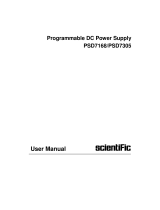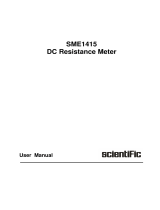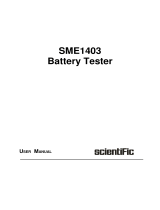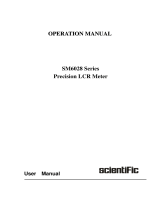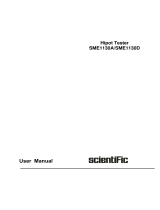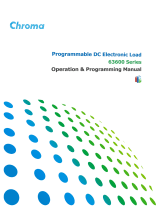Page is loading ...

Programmable DC Electronic Load
User Manual

Copyright © Scientific All rights reserved.
This instrument contains proprietary information, no part of this
manual may be photocopied, reproduced or translated without any
prior written consent.
Information in this manual supercede all corresponding previous
released material.
Scientific continues to improve products & reserves rights to amend
part or all of the specifications, procedures, equipment at any time
without notice.
Ver 1.00 / 0723
Scientific Mes-Technik Pvt. Ltd.,
B-14, Industrial Estate, Pologround,
Indore 452015 (India)
Tel : 0731-2422330/31/32/33
Email : sales@scientificindia.com
Website: www.scientificindia.com
Scientific
User Manual DC Electronic Load
2/120

5.2 Menu Operation .......................................................................................................................23
5.2.1 Main Introduction. ...................................................................................................................23
5.2.2 Load Page .......................................................................................................................24
5.2.2.1 Constant Current (CC) Mode.........................................................................23
5.2.2.2 Constant Voltage (CV) Mode. ........................................................................23
5.2.2.3 Constant Resistance (CR) Mode ....................................................................26
5.2.2.4 Constant Power (CP) Mode ...........................................................................26
5.2.2.5 Dynamic Current (DC) Mode 2........................................................................... 7
5.2.2.6 Dynamic Voltage (DV) Mode...........................................................................28
5.2.2.7 Dynamic Resistance (DR) Mode ..................................................................... 29
Preface
Important Symbols
1 About this Manual ........................................................................................................................9
1.1 Scope ...........................................................................................................................................9
1.2 Targeted Audience .......................................................................................................................9
2 Unpacking ....................................................................................................................................10
2.1 Packing List ............................................................................................................................10
2.2 Optional Components ............................................................................................................11
2.3 Checking for Shipping Damage ..............................................................................................11
3 Products Introduction ...................................................................................................................12
3.1 General Description ...............................................................................................................12
3.2 Product Features ....................................................................................................................12
3.3 Operating Instructions ............................................................................................................13
3.4 Operating Environments ........................................................................................................13
3.5 Protect Storage ......................................................................................................................13
3.6 Maintenance and Cleaning ....................................................................................................13
3.7 Power Supply Voltage ............................................................................................................14
3.8 Fuse .......................................................................................................................................14
3.9 Warm-up Time ........................................................................................................................14
4 Panel Descriptions .......................................................................................................................15
4.1 Front Panel Description ..........................................................................................................15
4.2 Rear Panel Description ...........................................................................................................17
5 Menu Operation ...........................................................................................................................18
5.1.2 Introduction to Operation Modes .........................................................................................20
5.1.3 Using the keys, Rotary knob and Touch Screen .................................................................20
Scientific
User Manual DC Electronic Load
3/120

5.2.2.8 Dynamic Power (DP) Mode ...3......................................................................... 0
5.2.3 Advanced Functions ...3..................................................................................................... 1
5.2.3.1 Battery Mode (Battery Discharge Timer) ...................................................... ..31
5.2.3.2 OCP/OPP 3...................................................................................................... 2
5.2.3.3 Program Mode ..............................................................................................34
5.2.3.4 CV-CC Mode .................................................................................................36
5.2.3.5 CV-CR Mode .................................................................................................36
5.2.3.6 CR-CC Mode .................................................................................................37
5.2.3.7 Auto Mode .....................................................................................................38
5.2.3.8 LED Mode ......................................................................................................39
5.2.3.9 External Waveform Function .........................................................................39
5.2.3.10 Fuse ..............................................................................................................39
5.2.3.11 RLC ...............................................................................................................40
5.2.3.12 Sweep ...........................................................................................................4 0
5.2.3.13 Sine ...............................................................................................................41
5.2.3.14 MPPT ...........................................................................................................41
5.2.4 Congure Page ................................................................................................................42
5.2.4.1 Load Setup ....................................................................................................42
5.2.4.2 Protection ......................................................................................................44
5.2.4.3 Paral/Sync ....................................................................................................44
5.2.4.4 SPEC Function ..............................................................................................45
5.2.4.5 Digitizing .......................................................................................................46
5.2.4.6 Timing ...........................................................................................................47
5.2.5 Save/Recall .....................................................................................................................47
5.2.6 Warning Log .....................................................................................................................48
5.2.7 System Setting .................................................................................................................49
5.2.7.1 Settings .........................................................................................................49
5.2.7.2 Date ..............................................................................................................49
5.2.7.3 RS232/485 ...................................................................................................50
5.2.7.4 TTL/Analog ...................................................................................................50
5.2.7.5 LAN ...............................................................................................................51
5.2.7.6 GPIB .............................................................................................................52
5.2.7.7 Info. ..............................................................................................................52
5.2.7.8 Factory .........................................................................................................52
5.2.7.9 Calibrate .......................................................................................................53
5.2.7.10 Upgrade ........................................................................................................53
Scientific
User Manual DC Electronic Load
4/120

6 Parallel Operation 54
6.1 Paralleling Procedure........................................................................................................55
7 Installation. .......................................................................................................................56
7.1 Overview and Dimensions ...............................................................................................56
7.1.1 Handle Installation..........................................................................................57
7.1.2 Casters Disassembly and Assembly ..............................................................57
7.1.3 Locking and Unlocking of Casters ..................................................................58
7.1.4 Installation of an Optional Intefrace Card ........................................................58
7.1.5 Installation Diagram of Electronic Load and Cabinet ......................................59
7.2 AC Input Connection .......................................................................................................60
7.3 Fuse Replacement ...........................................................................................................60
7.4 Load Connection ..............................................................................................................61
7.5 Remote Sensing Connection 62............................................................................................
7.6 External Control Interface .................................................................................................62
8 Troubleshooting .......................................................................................................................65
9. SCPI Command Descriptions ........................................................................................................66
9.1 IEEE - 488.2 Common Commands...................................................................................66
9.2 System Subsystem ...........................................................................................................67
9.3 Setting Operation Mode of Electronic load........................................................................68
9.4 Load Subsystem ..............................................................................................................69
9.5 Cong Subsystem ............................................................................................................71
9.6 Measure Subsystem ........................................................................................................79
9.7 Current Subsystem ..........................................................................................................80
9.8 Resistance Subsystem .....................................................................................................83
9.9 Voltage Subsystem ..........................................................................................................86
9.10 Power Subsystem ...........................................................................................................89
9.11 LED (CR) Subsystem .......................................................................................................92
9.12 Advance Subsystem .........................................................................................................94
9.13 Specication Subsystem ..................................................................................................107
9.14 Synchronous Subsystem .................................................................................................110
9.15 Program Subsystem .........................................................................................................111
9.16 Status Subsystem ............................................................................................................114
9.17 Fetch Subsystem ............................................................................................................115
9.18 Time meas Subsystem .....................................................................................................116
9.19 Digitizing Subsystem ........................................................................................................117
9.20 Communication Subsystem .............................................................................................119
10 Dispatch procedure for service, E-Waste Management & Warranty.............................................120
10.1 Dispatch procedure for service .....................................................................................................120
10.2 E-Waste ........................................................................................................................................120
10.3 Warranty .......................................................................................................................120
Scientific
User Manual DC Electronic Load
5/120

Important Symbols
!
!
Warning!
Caution!
This symbol highlights situations that are potentially dangerous, and highlights essential information
that must be understood by the user.
This symbol highlights the precautions that users need to take to avoid potential injury while
operating equipment.
This symbol highlights an important instruction that needs to be read before using the equipment.
This symbol indicates risk of exposure to high voltage and shock hazard.
This symbol indicates components of the supply that can be at high temperatures. Avoid
touching these areas during or immediately after operation of the supply to prevent burns.
This symbol indicates that a grounded connection is required before operating the equipment.
The input terminal with this label must be grounded to prevent possible electric shock.
In this manual, panel buttons are denoted by [ ], and software buttons / options are in bold type.
Note
Scientific
User Manual
6/108

Dear Customer,
Thank you for using EL Series Programmable DC Electronic Load. We sincerely hope this
product meets your needs.
This user manual is applicable to the following models:
* Custom master slave system could extend to 558KW(20 units 27.9KW E-load parallel connect).
*
2U
1200W
1800W
130A
190A
90A
130A
45A
2400W
3400W
260A 180A 90A
370A 250A 125A
3U 4400W 480A 320A 160A
5600W 610A 410A 205A
4U 6600W 720A 480A 240A
7U
8800W 960A 640A 320A
11000W
13200W
1200A
800A 400A
1440A
960A 480A
10U
15400W 1680A 1120A 560A
17600W
19800W
1920A
1280A 640A
2160A
1440A 720A
13U
22000W 2400A 1600A 800A
24200W
26400W
2640A
1760A 880A
2880A
1920A 960A
3000W 320A 220A
*
*
600W 60A 40A
8100W 720A 600A 300A
10300W 960A 760A 380A
12500W
1200A
920A 460A
14700W
1440A
1080A 540A
16900W 1680A 1240A 620A
19100W
1920A
1400A 700A
21300W
2160A
1560A 780A
23500W 2400A 1720A 860A
25700W
2640A
1880A 940A
27900W
2880A
2040A 1020A
Height Power Flippable
Front Panel
200V 600V 1200V
NO
NO
NO
NO
NO
NO
NO
NO
YES
YES
YES
YES
YES
YES
YES
YES
YES
YES
YES
YES
YES
YES
YES
YES
YES
YES
YES
YES
This series of electronic load series is divided into Advanced Versions and Professional Version
according to different applications. See the table below for a comparison of the two versions.
1
2
3
4
Dynamic frequency sweep
Sine wave dynamic load
High speed sampling rate
Non linear load
SupportedNot supported
SupportedNot supported
Supported
SupportedNot supported
5 User defined waveform SupportedNot supported
6 MPPT SupportedNot supported
NO. Description Single unit Professional version
( )
Single unit (Advanced version)
7 External waveform function Supported
Supported
Supported
20pcs20pcs
8 Parallel capability
Scientific
User Manual DC Electronic Load
7/120

Scientific
User Manual DC Electronic Load
8/120
Safety Notices
This symbol highlights operations that have the potential to endanger users. Operation
procedures and instructions must be understood completely before use.Documentation
This symbol indicates that the equipment must have a grounded connection. The terminal with this
label must be grounded to prevent electric shock.
If the equipment is used in a manner not specified by the manufacturer, the protection provided by
the equipment may be impaired.

Scientific
User Manual DC Electronic Load
9/120
Chapter 1 About this Manual
1-1
1.1 Scope
1.2 Targeted Audience
This manual provides the reader with detailed product information as well as installation, operation
and maintenance instructions. This manual also provides our company contact information so that
you can tell us your suggestions and comments about the performance of our products in order
that we can continue to improve our product quality and our level of service.
This manual is intended for product users and technical personnel that are involved with installing,
operating and maintaining the product. Readers are required to have a certain degree of electrical
and mechanical knowledge and be familiar with basic electrical and mechanical schematics.

Chapter 2 Unpacking
2.1 Packing List
Description Quantity
Item Remarks
A
C
D
E
F
G
H
I
J
K
M
N
L
B
O
1
1
1
EL Series High-density Programmable DC Electronic Load
USB Communication Cable
Sense Line (Red)
GPIB & LAN Card
GPIB Communication Cable 1
Sense Line (Black) 1
LAN Communication Cable
1
As ordered
Standard
Standard
Optional
Standard
System Bus Cable 1 Standard
1 Optional
1
DC Input Protective Cover Standard
1set
Screws Fasten item B and C
BNC Cable
RS-232 Communication Cable 1
2 Standard
Optional
AC Power Cable
1 Standard
2
Rack Mount Brackets Standard
Standard
Standard
AH
J K L
E
M O P
B C D G
N
IF
Q
P
Q
Strain relief bracket Support DC output cables
2, 13U(4)
Cable ties Fix output cables
2, 13U(4)
4
Pads (applicable in 2U, 3U, 4U)
ScientificScientific
User Manual DC Electronic Load
10/120

Scientific
User Manual DC Electronic Load
11/120
2.3 Product Failure and Maintenance
2.2 Checking for Shipping Damage
Caution!
All products have undergone stringent testing before delivery, but inevitably damage can happen
during transportation. Once you receive the product, please immediately check if there is any
packaging damage that may indicate damage to the product. If you find damage related to product
delivery, please immediately notify the transport company. Make sure to take photos documenting
the damage to the product, and send them to us so that we can provide you with the best service.
The load should not be carried by the front facing handles as they are not designed to carry the
entire weight of the unit. The front facing handles are present to assist in sliding the unit in and out
of cabinets.
Transporting the load by hand should be avoided when possible because it is very heavy. If it is
unavoidable, then a minimum of two people should carry the unit by the housing, and should not
grip exterior parts (handles, input/output terminals or rotary knobs).
In the unlikely event of product failure, please contact us in time to provide the serial number,
detailed failure information and pictures of the faulty product to help us identify the cause of the
failure. If the product need to be sent for repair, please pack it with the original packing material.
During the warranty period, the customer shall bear the freight and insurance costs for returning to
the maintenance center, and we bear the return cost to customer. Please do not return the product
without authorization from us.

Chapter 3 Products Introduction
3.1 Product Description
3.2 Features
●Flippable front panel and color touch screen for convenient access and operation.
CC, CV, CR, CP static load modes.
●
CV+CC, CV+CR, CR+CC load modes.
●
Adjustable voltage and current slew rates.
●
Ultra-high precision of voltage & current measurements.
●
Automated OCP/OPP testing function.
●
50kHz high-speed dynamic CC/CR mode.
●
500kHz high-speed voltage and current sampling rates.
●
Automated Timing & Discharging tests for batteries.
●
Auto mode function provides an easy way to do complicated test.
●
Short circuit test mode.
●
Auto mode for easily configured flexible test loads.
●
Dynamic frequency sweep function for determining worst case voltage peaks.
●
*
Non-linear load function for realistic load current.
●
*
Fully controllable by external hardware through External Control Interface.
●
Load voltage and current monitoring analog outputs.
●
LED load mode.
●
Full set of protections: OCP, OPP, OTP, over voltage and reverse polarity alarm.
●
Supports paralleling of up to 20 units using master/slave control.
●
Supports data upload and download through USB.
●
SCPI language compatibility and standard rack size make it ideal for ATE System integration.
●
Low noise smart fan control.
●
Multiple versions and power levels to meet a variety of applications.
●
*Only included in Professional versions
Scientific
User Manual DC Electronic Load
12/120
Electronic Loads (E-Loads) offer a variety of static load types in a single unit, including constant
current (CC), constant voltage (CV), constant power (CP) and constant resistance (CR) modes. E-
Loads also support Dynamic Load operations commonly used for performance and burn-in testing
of power equipment. The loads offer a full set of protections including over-current protection
(OCP), over-power protection (OPP), over-temperature protection (OTP), over voltage and
reverse polarity alarm. The Loads can be fully controlled and monitored by external hardware
through the External Control Interfaces. Standard RS232/RS485/USB communication interfaces,
LAN & GPIB communication card is optional. Synchronized and parallel connection of a number of
Loads is also supported, allowing the user to greatly increase total load capability.

3.3 Operating Instructions
3.4 Operating Environments
1. Scientific DCL Series Loads must be operated in a clean and dry environment with an ambient
temperature between 0°C and 40°C, with a relative humidity between 5% and 95%.
2. Do not use DCL Series E-Loads in high ambient temperature environments. OTP protections
may disrupt testing above 40°C ambient. Refer to the power derating curve in specification
for details.
3. DCL Series Load should be spaced at least 1meter away from walls and other obstructions to
ensure the efficient operation of forced air cooling.
4. Do not operate this product in an environment that contains large amounts of dust or
corrosive gases. Please do not subject the unit shock and vibration or expose it to intense
direct sunlight.
3.5 Product Storage
3.6 Maintenance and Cleaning
Scientific
User Manual DC Electronic Load
13/120
This product is a precision instrument, please read this manual carefully before using an E-Load.
In order to ensure measurement accuracy, it is recommended that all Loads be calibrated annually
by a calibration laboratory. To ensure user safety, the input power cable, connector, and
accessories of this product should be inspected annually.
Please store this product in an area with an ambient temperature between -20°C and 85°C, and a
relative humidity between 5% and 95% non-condensing. If the product will not be used for a long
period of time, please pack it the original carton or similar packaging and store it in a cool and dry
environment.
Before cleaning an E-Load, the AC input power cable and source power must be disconnected.
Gently wipe off any dust from the unit's exterior using a brush, sponge, or cloth, together with a
small amount of non-aqueous cleaning solution such as isopropyl alcohol. Do not use a corrosive
or abrasive cleaning solution to clean this product. The display front panel can be cleaned with a
cloth dampened in soft detergent. Removal of dust from the interior of this product must be carried
out with a low-pressure air gun. To prevent damage to internal components, we suggest that such
cleaning be performed by an authorized dealer on behalf of the user.

3.7 Power Supply Voltage
Ensure that the front panel which is in the OFF state and the AC input voltage is within the product's
operating specification before connecting to the AC mains.
!
Caution!
3.8 Warm-up Time
In order to achieve the specified operating accuracy, the E-load should be powered on for a
warm up of 30 minutes before use.
3.9 Starting Procedure
When the DCL Series Load is switched on, the unit will enter a start-up diagnostic routine to verify
the integrity of the Load.
To avoid burning out and electric shock, please only use the power cord supplied as a standard
accessory.
To prevent electric shock, be sure to take protective earthing. Please connect the power cable to
the socket with the protective earth terminal.
The diagnostic self-check will take several seconds to complete. If all check results are good,
the unit will revert to the default screen. If any faults are detected during this test, please
contact Customer Support
Self Checking
Model:
Serial No.
License
Display Version
Communication Ver.
Controller Ver.
Initial Data
SelfCheck Result
DCL600-4800
0157971921000001
Advanced
V100R001C02
V100R001002
OK
OK
OK
OK
OK
OK
OK
Front Panel-4U Models as example
V100R003C31
Scientific
User Manual DC Electronic Load
14/120

Chapter 4 Panel Description
4.1 Front Panel Description
2
3
4
1
Power on/off switch
Color touch screen
Numeric and function keys
USB host, for data import and export
Keys
0 9
~
CC Shift +
( )
ESC
0
.
CV Shift +
( )
4
CR Shift +
( )
5
CP Shift +
( )
6
BATT Shift +
( )
7
OCP/OPP Shift +
( )
PROG ( Shift + )
9
/ ( LOCAL )
RangeA/BMain Cursor
ShiftOn/off
ESC 123
0 4 5 6
789
4 5 6 7 981 2 3
Numeric keys
Esc key
CC mode
CV mode
CR mode
CP mode
Battery discharge timer
OCP or OPP test function.
Program function
Name and the function Manual Reference
[0]~[9]
[.] / ( [LOCAL] )
[ESC]
[Shift]+[0]
[Shift]+[4]
[Shift]+[5]
[Shift]+[6]
[Shift]+[7]
[Shift]+[8]
[Shift]+[9]
8
Decimal point key / Keypad unlock function
key / Enter Local Control mode if in Remote Control.
Front Panel-4U Models as example
Scientific
User Manual DC Electronic Load
15/120

6
[Shift]+[ ]
[Shift]+[ ]
[ ]
[ ]
[Enter]
Recall configuration from memory
Saves configuration to memory
Moves the cursor to the previous menu position
Used to move the cursor to the next menu position
Confirm key
RECALL ( Shift + )
STORE ( Shift + )
Enter
5
[A/B]
[Cursor]
[Main]
[On/off]
[Shift]
[Shift]+[Cursor]
[Shift]+[A/B]
[Shift]+[Main]
[Range]
A/B
Cursor
Main
On/Off
IMAGE/FILE ( Shift + )
LOCK ( Shift + )
SPEC ( Shift + )
Switches load from A setting to B setting
Shift
Function keys and multifunction keys
Keys Name and the function Manual Reference
Brings up cursor on screen
Press to return to the Main screen
On/Off control for load function
Short circuit test function
Selects the alternate functions keys that have a
secondary text label directly below
Screen snapshot/importing
Enables SPEC testing, displays GO/NG status
when enabled.
Locks the front panel keys and touch screen
function
Selects Voltage/Current range of load
Enter key and arrow keys
Keys Name and the function Manual Reference
SHORT ( Shift + ) [Shift]+[Range]
Range
Main
A/B
Cursor
Range
8
9
7
Ventilation holes
Push-on knob, for editing parameter and moving the location of cursor
Stylus
Scientific
User Manual DC Electronic Load
16/120

7
1
2
3
5
8
4
6
4.2 Rear Panel Description
* If the LAN/GPIB interface card selected on order, it will be installed in place of the RS232/RS485
/USB interface card.
Load positive/negative terminal
Remote sense connections
System Bus connectors for mater/slave connections
External TTL/Analog control interface
Fan Exhaust Grate
RS485/RS232/USB communication Interface (standard), LAN & GPIB communication
Interface (optional) *
V-monitor/I-monitor
AC input connector
Rear Panel-4U Models as example
1 2 3 54 6 786
600
Scientific
User Manual DC Electronic Load
17/120

Chapter 5 Menu Operation
5.1 Menu Introduction
5.1.1 Menu Structure
Scientific
User Manual DC Electronic Load
18/120

Scientific
User Manual DC Electronic Load
19/120

Scientific
User Manual DC Electronic Load
20/120
5.1.2 Introduction to Operation Modes
5.1.3 Using the Keys, Rotary Knobs, and Touch Screen
Using front panel keys to set a CC load:
The following examples below will demonstrate how the front panel key switches, rotary knob,
and touch screen can be used to interact with the Load. These examples include configuring a
constant current load and navigating the main menu page.
1. The Front panel [On/off] key is used engage and disengage the load.
2. When in Local Control mode, the load is controlled through the front panel interface. When
operating in Remote Control or External Control, the Load is controlled by a remote computer,
master load, or external control circuitry.
3. All front panel keys are functional when the load is in Local Control mode.
4. While under Remote Control, all front panel keys are locked except the [.]/[Local] key. Pressing
the [.]/[Local] key while under remote control will revert the load to Local Control.
1. Press the [Shift] key then the [0] key to select the load page and CC mode.
2. Press the [Cursor] key and use the two arrow keys on either side of the [Enter] key to move
the cursor to the A parameter setting field.
3. Press the [Enter] key to select the A parameter, and use the [0]~[9] keys to enter the desired
CC value. Press [Enter] again to confirm the value.
/
